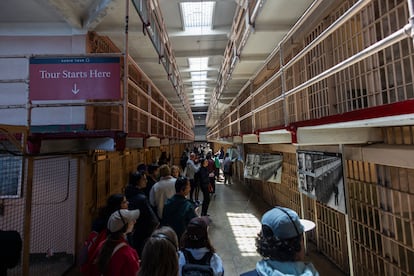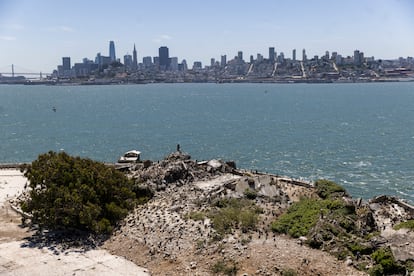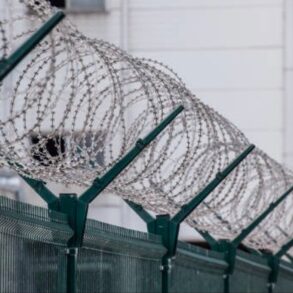On a large black-and-white photograph, an ominous phrase — “Break the rules, and you go to prison; break the prison rules, and you go to Alcatraz” — greets the hundreds of tourists who visit the world’s most famous prison every day. They call it “The Rock” because it stands on a 22-acre island, just over a mile away from San Francisco.
The message of dissuasion has taken on a new meaning since Sunday, May 4, when U.S. President Donald Trump echoed Alcatraz’s infamous reputation on his Truth Social account, with the announcement that he would “REBUILD, AND OPEN ALCATRAZ!” He claimed that, under his administration, the penitentiary would be “substantially enlarged and rebuilt,” with the purpose of housing “America’s most ruthless and violent offenders.” The next day, he repeated the remark and again linked immigration with crime.
It’s just after 10 a.m. And, just like almost every day, fog covers the Golden Gate Bridge and part of San Francisco Bay. A ferry from Alcatraz City Cruises departs from the pier. Packed with tourists, it heads to the former penitentiary. The experience costs $48 and lasts about three hours. Nearly one-and-a-half million people from around the world visit the facility each year.

The ferry arrives at the islet about 15 minutes later. It docks in front of the apartment building where the prison workers and their families once lived. On the facade, graffiti recalls that this inhospitable place was once “Indian land.” Alcatraz Island served first as a barracks (1853-1907), then as a military prison (1907-1930) and, finally, as a civilian penitentiary (1934-1963). It was shuttered because it became too expensive to maintain.
In addition to being a reminder of bygone times, it’s also a symbol of the struggle for Native American rights. Indigenous peoples occupied the island on three occasions (the last time was in 1969), when they controlled it for 19 months. A small guidebook — sold for a dollar — recalls that they attempted to buy the island back from the government for $24 and other goods. However, a glance at the group of tourists who just disembarked confirms that the federal government preferred to use the property for another purpose: the booming heritage tourism industry. Something that Trump now seeks to change.
The itinerary simulates a prisoner’s entry into jail. For a few hours, the visitor feels like an inmate who is about to be trapped within those walls. You enter through the shower room, although each tourist receives an audio guide, rather than a bar of soap.
Terry Woolsey — a 79-year-old retired engineer from Kansas — protects himself from the sun with a blue cap, which identifies him as a Vietnam veteran. “Trump is a poker player,” he opines. “He throws down his cards to see who’s playing and, in the process, he sees if he’ll commit.”
“From my profession,” Woolsey adds, “I know that it would be an impossible mission to get this prison back online. Besides, it would be very expensive. Food and water can only come from one place: solid ground.”
The man defines himself as a conservative and — like Trump — believes there are too many dangerous criminals on the streets of the United States and that the number of prisons needs to be expanded. He also calls his 79-year-old wife, Anne, a “socialist.” She chimes in to state that she disagrees with the government’s policies, “especially when they accuse refugees of being criminals.”

On the engineering front, Woolsey is correct: putting Alcatraz back in the service of the criminal justice system would require an almost complete reconstruction. Some buildings are in ruins, without roofs and with walls propped up to prevent collapse. Many areas are closed off for security: parts of their walls have fallen down. On the ramp leading to the morgue and water tank, red tape warns of a recent collapse. In the main cellblock, several door mechanisms are inoperable, while rust covers the pipes that once served as the heating system. Its cramped cells — measuring 8.8 by 4.9 feet — are in a sorry state. Many sinks and toilets are smashed, with the drains sealed. Everywhere, the walls are peeling.
In another demonstration of his troubled relationship with the truth, on Monday, May 5, Trump claimed that no one has escaped from the legendary prison. The truth is that, during the 29 years it was in operation, there were 11 escape attempts — and at least five of them were successful. The most famous feat is that of Frank Morris and the Anglin brothers. They managed to escape in 1962 with a meticulous plan: they designed papier-mâché dummy heads (with real hair) to fool the guards into thinking they were asleep. They also used spoons to dig into the wall. The feat served as the raw material for the film Escape from Alcatraz (1979), a prison classic starring Clint Eastwood.
The island has been the setting for many other films, which have contributed to its enormous popularity. California Governor Gavin Newsom, of the Democratic Party, took to the cinema in Sacramento on Tuesday, May 6, to respond to Trump. He spoke about a 1996 movie starring Sean Connery and Nicolas Cage. “I don’t know if [the president] is watching The Rock… nothing about this makes any sense,” Newsom declared, adding with a certain poetic quality that Trump’s plan has “the form and substance of the stuff that flows in and out of the bay over Alcatraz every day: fog.” San Francisco Mayor Daniel Lurie agreed that “it’s not a serious proposal.”
From one corner of the cellblock, you can access the courtyard — the only place where the prisoners could enjoy the outdoors. The floor is covered in bird droppings. Grass sprouts between the cracks in the concrete. This island also has a high ecological value as an important bird sanctuary. On the other side, behind a rusty gate, thousands of Cormorants perch on their nests, watching the tourists. Western gulls soar above the prison. And the National Park Service — responsible for managing Alcatraz — has spotted other species on the island, such as the night heron and the Columbian Guillemot.
In the background, the skyline of San Francisco can be seen. “I think it’s more of a show of force than a feasible idea,” says Pauline Catazzo, a 30-year-old Frenchwoman, after taking a photo with the Golden Gate Bridge in the background. “It’s a paradox that he wants to raise money with tariffs to lower taxes… and then he says this kind of thing.”
On the fence separating the kitchen from the cafeteria, there’s a panel with the last meal service still written on it: breakfast on March 21, 1963. Cereal, scrambled eggs, milk, coffee and toast. Next to this sign, 32-year-old Miguel Astorga — a Californian teacher — keeps an eye on the students he took on a field trip this May morning.
“San Francisco is a city with a very interesting past. This prison is part of it. I teach history, and my students aren’t that interested in the subject matter. Here, they can experience an important part of their country’s recent past,” he explains.
Regarding Trump’s plans, he adds: “I think he wants to hit this area of California because it’s predominantly Democratic. And he’s using this announcement — once again — to instill fear, as he did with the deportations of immigrants to El Salvador.”
After touring the conference room, looking at photos of the most famous prisoners — from Al Capone to Robert Stroud, aka “Birdman” — and walking past the offices and the lighthouse, the visit to Alcatraz ends where it began: on the pier. Passengers board the same ferry they arrived on: The Alcatraz Clipper. The small crew — as well as the National Parks employees who manage this island — will be the first affected by Trump’s plans if he succeeds in implementing them.

Alcatraz is a good business: it rakes in $60 million annually from ferry tickets, tours and sales at the souvenir shop. Both the concessionaire — which has a monopoly on transporting travelers to the island — and the National Park Service have remained silent about the prison’s conversion proposal. They also didn’t respond to questions from EL PAÍS.
When the last of the tourists have boarded The Alcatraz Clipper, the ferry sets sail. No one wants to be left behind. The visitors — who have been kept as prisoners for a few hours — leave feeling like they’ve escaped from the world’s most famous maximum-security jail.
Perhaps the days of these short tours are numbered. If Trump’s plans come to fruition, those who arrive at Alcatraz will be there for a much longer visit.
Sign up for our weekly newsletter to get more English-language news coverage from EL PAÍS USA Edition
This post was originally published on this site be sure to check out more of their content.








